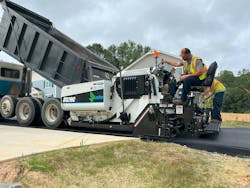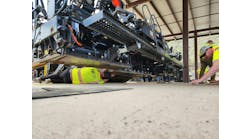By Tom Berg, Contributing Author
Electric propulsion, now famously sold in automobiles and trucks, has extended to asphalt pavers, as equipment manufacturers continue supporting a gradual move toward a carbon-free future. However, market acceptance is marked more by curiosity than sales, and only a few of the two available products have been ordered by customers, say representatives from Dynapac and LeeBoy, which introduced them in the last year and a half.
Dynapac announced its SD1800W e in autumn of 2022, and garnered an order from a construction company in Sweden, according to Joado Prado, the product manager. LeeBoy showed its 8520C Electric in early 2023 and got an order from a municipality; it will be built in April, said Chris Broome, senior product manager.
Each builder replaced the diesel engine, radiator and fuel tank in its popular asphalt-placement machine with an electric motor, battery pack and battery cooling system. They retained the same hydraulic systems, now run by a motor instead of a diesel, and familiar controls so operators need little to no training to run the electric machines.
Dynapac uses 55-kiloWatt 3-phase electric motor and 98kiloWatt-hour lithium-ion battery; LeeBoy’s has a 48-kWh battery and a 150-kW motor “trimmed back to one-third because that’s all we need,” Broome said. LeeBoy’s entire powertrain comes from General Motors with engineering support from Powertrain Control Solutions.
Both e-pavers are aimed at users who want to reduce carbon emissions and noise, which are increasingly important considerations in urban settings to calm otherwise angry neighbors. Dynapac’s Prado thus calls its product the City Paver. Quietness, cleanliness and lack of vibration also benefit the paving crew, noted LeeBoy’s Broome: “Where you normally would not have a normal conversation while standing on the back of the (diesel) machine, now you can have a normal conversation” with the electric paver.
However, while the e-machines are based on diesel models, they are not direct replacements. The Dynapac can run about four hours while laying down asphalt, then needs a recharge, Prado said. The LeeBoy’s time limit might be similar, but battery life depends on the amount of material being handled in a given time span, Broome said.
An e-paver does not have the same pushing power as the diesel version, and “pavers must push a dump truck plus 20 tons of asphalt and its own weight,” he said. Those limits mean current e-pavers cannot lay down the sheer amount of asphalt as diesels, which contractors do in road and street paving; there, output can total 500 tons in a day. But a municipal crew might do 100 to 150 tons, which an e-paver can handle. And it has an energy advantage.
“Whenever we come to a stop, it (the electric powertrain) spins down and we don’t use any power,” he said. “But a diesel runs all day. So we’re much more efficient in energy usage. The emissions on some job sites – in the future we’re going to see more and more (bid requests) that specify noise limits and emissions limits. Government agencies will specify where you can use certain machinery.”
Diesels work well for contractors because they run their machines continuously. A big road project employs multiple asphalt-hauling trucks, and they tend to line up, making for quick reloading of the hopper and almost non-stop asphalt placement. But municipal and state crews work more slowly; only one, two or three trucks might be involved, and as they leave the site to get more loads, the paver pauses and waits as crew members use shovels, rakes and brooms to groom the freshly laid material.
During those downtimes, the e-paver can be recharged. Dynapac and LeeBoy have trailer-borne provisions for on-site recharging. Broome said LeeBoy’s charging pack is a large battery with operating controls and cords that weighs about 6,000 pounds – light and compact enough to fit in the bed of an F-150-size pickup.
Back at a maintenance and storage facility, an e-paver can be charged overnight using industry standard connectors and cords, and a Level 2 or 3 station that plug into 120- or 240-volt sources. Charging rate for the LeeBoy is 1 percent per minute. Another e-paver advantage is reduced maintenance for the absent diesel, which makes it more attractive to potential customers.
The 8520C E’s electric system is going into a new electric power broom, Broome said with no attempt at a pun. It will be introduced at the World of Asphalt Conference and Show in Nashville, Tenn., this month. RB



